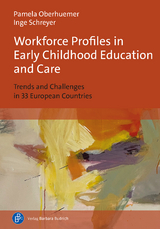Workforce Profiles in Early Childhood Education and Care
Verlag Barbara Budrich
978-3-8474-3071-1 (ISBN)
Preface and acknowledgments
Introduction to SEEPRO-3
SEEPRO-3 – project with a history
SEEPRO-3 – background, aims and procedures
Part I: Contextualising the ECEC workforce
1 Conceptual framework – a 'science of difference'
2 Three ECEC system types: unitary, part-integrated, bi-sectoral
3 Key policy measures since the previous SEEPRO study
3.1 Legislative changes
3.2 Curricular reforms
3.3 Measures to improve access to ECEC
3.4 Personnel-related measures
4 Contextual Framework
4.1 Legal entitlement and compulsory enrolment in ECEC
4.2 ECEC providers and main setting types
4.3 Curricular frameworks – digital education
4.4 Evaluation and assessment
4.5 Inclusion and transitions
4.6 Working parents, parenting leave and post-leave entitlement to ECEC
Part II: The ECEC workforce
5 Key pedagogical and specialist support staff
5.1 Core practitioners: minimum qualification requirements and professional profiles
5.2 Centre leaders in ECEC
5.3 Assistant co-workers
5.4 ECEC counsellors, supervisors and inspectors
5.5 Specialist support staff
5.6 Staff in ECEC settings by qualification and gender: an overview
6 Initial professional education of core practitioners
6.1 What competences do ECEC core practitioners need? Competence profiles in six countries
6.2 Curriculum in ECEC initial professional education: Six country examples
6.3 Field practice in the initial professional education of ECEC core practitioners
7 Alternative routes into the ECEC professions – lateral entry
8 Continuing professional development in the early childhood field
8.1 Legislation and regulatory frameworks
8.2 Providers and main forms of continuing professional development
8.3 Continuing professional development as an entitlement and a duty
8.4 Participation in continuing professional development measures as a requirement for career promotion
8.5 Current topics in CPD
8.6 Availability of continuing professional development for ECEC assistant co-workers
9 Newly qualified and newly appointed staff: Support measures in the workplace
Part III: Reform initiatives – workforce and ECEC system challenges
10 Staff-related policy initiatives and reform strategies
10.1 Initiatives to improve initial professional education
10.2 Strategies to improve working conditions and measures to combat staff shortages
10.3 Staff-related reforms as part of overall educational policy strategies
11 Staff-related and system-related challenges from a country expert perspective
11.1 Staff shortages
11.2 Staff to child ratios
11.3 Initial professional education of core practitioners
11.4 Continuing professional development opportunities for centre leaders, core practitioners and assistant co-workers
11.5 Integration at the ECEC system level
11.6 Equitable access to early childhood education and care settings
11.7 Further challenges from a country expert perspective
12 Summary and outlook
12.1 Contextual framework
12.2 Early childhood staff
12.3 Reform strategies – staff and system-related challenges
12.4 Outlook
References
About the authors
SEEPRO-3 Cooperation partners in 33 countries (2021–2024)
Glossary
Index
| Erscheinungsdatum | 28.10.2024 |
|---|---|
| Verlagsort | Leverkusen-Opladen |
| Sprache | englisch |
| Maße | 148 x 210 mm |
| Gewicht | 240 g |
| Themenwelt | Sozialwissenschaften ► Pädagogik ► Sozialpädagogik |
| Sozialwissenschaften ► Pädagogik ► Vorschulpädagogik | |
| Schlagworte | Arbeitsbedingungen • Arbeitskontexte • Cross-national analysis • ECEC • ECEC systems • ECEC workforce • Erstausbildung • Europäische Forschung • European Research • Frühkindliche Bildung und Kindertagesbetreuung • frühpädagogische Kita-Systeme • länderübergreifende Analyse • pädagogische Fachkräfte • Professionalisierung • Staff Education • Staff training • Working conditions • working contexts |
| ISBN-10 | 3-8474-3071-8 / 3847430718 |
| ISBN-13 | 978-3-8474-3071-1 / 9783847430711 |
| Zustand | Neuware |
| Informationen gemäß Produktsicherheitsverordnung (GPSR) | |
| Haben Sie eine Frage zum Produkt? |
aus dem Bereich




